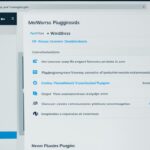Table of Contents
Welcome to our comprehensive WordPress How-To Guide, where we will share valuable tips, tricks, and hacks to help you customize and optimize your WordPress website. Whether you’re a beginner or an experienced user, these tips will empower you to make the most out of WordPress and enhance your website’s functionality. From customizing your homepage to installing useful plugins and securing your admin directory, we’ve got you covered. Let’s dive in!
In this section, we will explore various tips, tricks, and hacks to help you customize and optimize your WordPress website. These include:
- Customizing your homepage to create a personalized online presence
- Installing Google Analytics for valuable insights into your website’s performance
- Password protecting the admin directory to enhance your website’s security
- Displaying images in rows and columns for a visually appealing image gallery
- Enabling comment subscriptions to engage with your audience
These tips will not only help you customize your site but also ensure you use WordPress efficiently, saving you time and effort along the way.
Ready to take your WordPress website to the next level? Let’s get started with the first tip: customizing your homepage.
Customizing the Homepage
One of the most effective ways to personalize your WordPress website is by creating a custom homepage. By default, WordPress displays the latest posts on the homepage, but you have the option to change this and create a unique experience for your visitors.
To create a custom homepage, follow these steps:
- Create a new page: Go to your WordPress dashboard and click on “Pages” in the sidebar. Then, click on “Add New” to create a new page for your custom homepage.
- Select the static homepage: After creating the new page, go to “Settings” in the sidebar and click on “Reading.” In the “Your homepage displays” section, choose the “A static page” option. Then, select the new page you just created as the “Homepage.”
- Customize the homepage template: Now that you have set a static homepage, you can further customize it by creating a custom template. There are two ways to do this:
1. Using the site editor: If your WordPress theme supports it, you can use the built-in site editor to design the layout of your custom homepage. This visual interface allows you to drag and drop different elements, add images, and customize the appearance of your page without any coding knowledge.
2. Manually creating a custom template file: If you have coding skills or want more control over the design, you can manually create a custom template file. To do this, you need to create a new file in your theme’s directory and use HTML, CSS, and WordPress template tags to define the structure and styling of your custom homepage.
Example: Custom Homepage Template
Here’s an example of a custom homepage template code:
<!-- Custom Homepage Template -->
<!-- Header section -->
<header>
<h1>Welcome to My Custom Homepage</h1>
</header>
<!-- Featured content section -->
<section id="featured">
<h2>Featured Content</h2>
<p>Lorem ipsum dolor sit amet, consectetur adipiscing elit. Nullam sodales urna ac justo porta, nec egestas nunc sodales.</p>
<img src="https://seowriting.ai/32_6.png" alt="Custom Homepage Example">
</section>
<!-- Latest posts section -->
<section id="latest-posts">
<h2>Latest Posts</h2>
<ul>
<li>Post 1</li>
<li>Post 2</li>
<li>Post 3</li>
</ul>
</section>
<!-- Footer section -->
<footer>
<p>Copyright © 2022 My Website. All rights reserved.</p>
</footer>
This template code includes a header section, a featured content section, a latest posts section, and a footer section. You can modify this code to suit your specific needs and design preferences.
By customizing your homepage, you can create a unique and memorable first impression for your visitors, and guide them to the most important sections of your website.
Installing Google Analytics
Google Analytics is a powerful tool that allows users to track and analyze their website’s performance. By providing insights into website traffic, user behavior, and conversion rates, Google Analytics empowers website owners to make informed decisions to optimize their sites. To install Google Analytics on a WordPress website, users can take advantage of the MonsterInsights plugin, which simplifies the installation process and allows for easy access to Google Analytics reports.
With Google Analytics set up, users can gather valuable data about their website’s visitors, including demographics, geographic location, and traffic sources. This data can drive data-driven decisions for website design, content strategy, and marketing campaigns. By monitoring key metrics such as page views, bounce rates, and conversion rates, users can identify areas for improvement and take action to enhance their website’s performance.
The MonsterInsights plugin seamlessly integrates Google Analytics with the WordPress platform, enabling users to view detailed analytics reports directly in their WordPress admin area. This eliminates the need to switch between multiple platforms and provides a convenient way to track and monitor website performance.
If you’re not tracking your website’s performance with Google Analytics, you’re missing out on valuable insights that can help you optimize your online presence. Install Google Analytics today and unlock the power of data-driven decision-making.
With Google Analytics installed, users can harness the following benefits:
- Track website traffic and monitor audience behavior
- Identify the most popular pages and understand user engagement
- Measure the effectiveness of marketing campaigns and track conversions
- Analyze the performance of different traffic sources
| Benefits of Installing Google Analytics |
|---|
| Track website traffic and monitor audience behavior |
| Identify the most popular pages and understand user engagement |
| Measure the effectiveness of marketing campaigns and track conversions |
| Analyze the performance of different traffic sources |
By leveraging the insights provided by Google Analytics, users can make data-driven decisions to enhance their website’s performance, improve user experience, and achieve their online goals.
Password Protecting the Admin Directory
Password protecting the WordPress admin directory adds an extra layer of security to your website. By requiring users to enter a username and password before accessing the admin area, you can help prevent unauthorized access and protect sensitive information.
To enable password protection for the admin directory, you can follow these steps:
- Login to your hosting control panel.
- Navigate to the directory privacy settings.
- Enable password protection for the wp-admin folder.
By implementing this security measure, you can safeguard your WordPress site from potential hackers and minimize the risk of unauthorized access to your admin area.
| Benefits of Password Protecting the Admin Directory |
|---|
| Enhanced Security |
| Prevents Unauthorized Access |
| Safeguards Sensitive Information |
“Password protecting the admin directory adds an extra layer of security to your WordPress site, helping to prevent unauthorized access and protect your website’s valuable data.” – Security Expert
Displaying Images in Rows and Columns
By default, WordPress displays multiple images in a post or page one after the other, which can result in a long scrolling experience for users. However, users can create a more visually appealing image gallery by displaying images in rows and columns.
There are several ways to achieve this in WordPress:
- Using the Gallery block: WordPress provides a built-in Gallery block that allows users to easily add and arrange images in a grid layout. Simply select the Gallery block, add the desired images, and customize the layout and settings to create a visually appealing image gallery.
- Using the Columns block: Another option is to utilize the Columns block to create multiple columns and then insert individual images into each column. This allows users to display images side by side, creating a neat and organized grid layout.
- Using the Text and Media block: Users can also combine text and images using the Text and Media block. By inserting images alongside text and adjusting the layout, users can create a customized image gallery with a grid-like appearance.
This grid layout not only enhances the user experience but also makes it easier for visitors to view and browse through multiple images without extensive scrolling.
To further illustrate, here is an example image gallery created using the Gallery block:

With the ability to display images in rows and columns, WordPress provides users with the flexibility to design stunning image galleries that showcase their content effectively.
Enabling Comment Subscriptions
By default, WordPress does not notify users when new comments are posted on their website. However, users can enable comment subscriptions to allow users to receive email notifications when new comments are added to a post. This can help facilitate discussions and engagement on the website.
Users can use the Subscribe to Comments Reloaded plugin to add this feature to their WordPress site. This plugin allows users to customize the comment subscription settings and provides an easy way for users to manage their comment notifications.
With comment subscriptions enabled, users can actively engage with their website visitors by responding to comments in a timely manner. This not only fosters a sense of community but also encourages repeat visitation and promotes user-generated content. By nurturing discussions through comment notifications, WordPress users can enhance user engagement and create a vibrant online community.
Subscribe to Comments Reloaded Plugin
The Subscribe to Comments Reloaded plugin is a valuable tool for enabling comment subscriptions on WordPress websites. With this plugin, users can:
- Allow visitors to subscribe to comment threads, receiving email notifications when new comments are added.
- Customize the appearance and content of their comment notification emails, creating a branded and personalized experience for subscribers.
- Provide multiple subscription options, giving users the flexibility to choose how frequently they receive comment notifications.
- Manage comment subscriptions easily, allowing users to unsubscribe or update their notification preferences with ease.
The Subscribe to Comments Reloaded plugin empowers WordPress users to stay connected with their audience and foster meaningful conversations within the comment section. By encouraging comment subscriptions, website owners can create a dynamic and interactive platform for users to engage and connect with each other.
Conclusion
In conclusion, these WordPress tips, tricks, and hacks provide valuable insights for users to optimize and enhance their WordPress websites. By implementing these strategies, users can take full advantage of the platform’s versatility and improve the overall user experience.
From creating a custom homepage and installing Google Analytics to password protecting the admin directory and displaying images in rows and columns, these tips offer practical solutions to enhance website functionality. By customizing the homepage, users can create a unique and personalized experience for their visitors.
Installing Google Analytics allows users to gain valuable insights into their website’s performance and make informed decisions to optimize their site. Password protecting the admin directory adds an additional layer of security, protecting the website from potential threats.
Displaying images in rows and columns enhances the visual appeal of the website, providing a better browsing experience for users. Enabling comment subscriptions facilitates engagement and improves the communication between users and website owners, fostering a sense of community.
By implementing these WordPress tips, tricks, and hacks, users can enhance the functionality and user experience of their websites, ultimately optimizing their WordPress sites to their full potential.
FAQ
How can I customize the homepage of my WordPress website?
To customize the homepage of your WordPress website, you can create a new page specifically for your homepage and set it as the static homepage in the WordPress settings. Additionally, you can further customize your homepage by creating a custom template using the site editor or by manually creating a custom template file with HTML, CSS, and WordPress template tags.
How do I install Google Analytics on my WordPress website?
To install Google Analytics on your WordPress website, you can use the MonsterInsights plugin. This plugin simplifies the installation process and allows you to view Google Analytics reports directly in your WordPress admin area. Google Analytics provides valuable insights into your website’s performance, traffic, user behavior, and conversion rates, helping you make informed decisions to optimize your site.
How can I password protect the admin directory of my WordPress site?
You can add an extra layer of security to your WordPress site by password protecting the admin directory. This can be done by accessing your hosting control panel, navigating to the directory privacy settings, and enabling password protection for the wp-admin folder. By doing so, you can help protect your site from potential hackers and unauthorized access.
How can I display images in rows and columns on my WordPress site?
By default, WordPress displays multiple images in a post or page one after the other. However, you can create a more visually appealing image gallery by displaying images in rows and columns. You can achieve this by utilizing the Gallery block, Columns block, or Text and Media block in the WordPress editor. These blocks allow you to arrange images in a grid layout or side by side, enhancing the user experience and making it easier to view and browse through multiple images.
How do I enable comment subscriptions on my WordPress website?
By default, WordPress does not notify users when new comments are posted on their website. However, you can enable comment subscriptions by using the Subscribe to Comments Reloaded plugin. This plugin allows users to customize their comment subscription settings and receive email notifications when new comments are added to a post. Enabling comment subscriptions can help facilitate discussions and engagement on your website.
Are there any other tips, tricks, or hacks to optimize my WordPress website?
Absolutely! In addition to the tips mentioned above, there are various other ways to customize, optimize, and enhance your WordPress website. From utilizing plugins to improve site speed, implementing SEO best practices, optimizing images for faster loading times, and managing user roles and permissions, there are numerous strategies you can employ to make the most out of your WordPress site. Stay tuned for more insights and tips in our WordPress How-To Guide.













